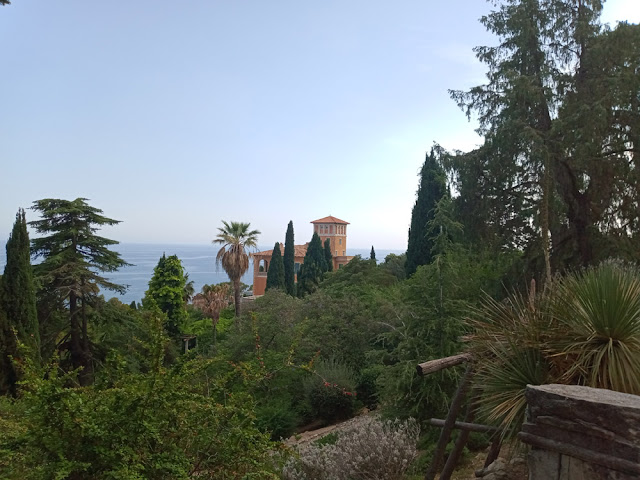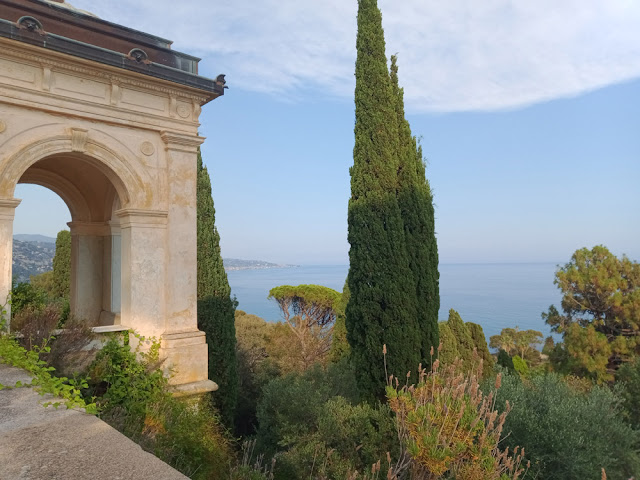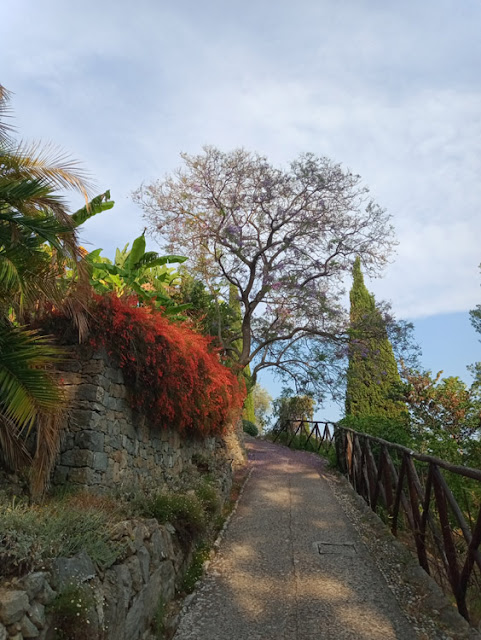Hanbury Gardens, or to give them their Italian name, Giardini Botanici Hanbury, are on a small peninsula on the Ligurian coast of Italy, near Ventimiglia. They are managed by the University of Genoa.
They were created by Sir Thomas Hanbury, a wealthy British Quaker and businessman, in the grounds of the Palazzo Orengo, which he bought in 1867. On the team were his brother Daniel, a pioneering vegetarian and pharmacologist; the German landscape gardener Ludwig Winter, who is largely responsible for the look of the gardens and the planting combinations; and other leading German botanists, explorers and scientists who over the years documented the garden, producing a plant list of 5800 species and managing the distribution of seeds and plant material to other gardens and interested parties.
Palazzo Orengo through the trees.
Winter in particular was influential in introducing palms and other exotic species to the Ligurian coast. Now we think of this type of planting on the Mediterranean as commonplace, sensible and unremarkable but in the mid-19th century it was radical, unexpected and daring. Born in Prussia, he was Head Gardener at the Tuileries in Paris when the outbreak of war between the Prussians and the French forced him to move to Italy. Hanbury hired him and he worked there for five years, establishing the garden. Then he bought his own estate and became a horticultural consultant and nurseryman to many wealthy landowners along the French and Italian Riviera and Cote d'Azur. He had a particular interest in Acacia species as well as palms, figs and roses.
There were several stunning agaves in the garden.
Daniel Hanbury's botanical collection is now in the care of Kew Gardens.
Thomas Hanbury died in 1907, but after the First World War, his daughter-in-law Dorothy, who came from a family of garden designers, took the garden on and continued in the same vein. Sadly, during the Second World War the gardens were badly damaged as they were at first confiscated because they belonged to foreigners, then occupied by troops, and finally bombed and looted. Although Dorothy returned to live there after the War, the task of restoring the gardens was too great for her to manage and in 1960 Lady Dorothy Hanbury sold the gardens to the Italian State, in order to protect them from speculative building developments.
There were some impressive cacti too.
Nowadays, after nearly 40 years of extensive restoration by the University of Genoa, half of the estate's 18 hectares are open to the public, the gardens are a nature reserve listed as a UNESCO World Heritage site, and regularly get listed in the Top Ten most beautiful gardens in Italy.
The citrus grove has only fairly recently been rediscovered, after having been presumed destroyed. It has examples of rare species.
The notable collections include agaves, aloes, Australian flora, salvias, olives, palms, succulents, euphorbias, rare fruits, citrus and certain conifers.
Sir Thomas Hanbury's tomb is in the little Indian pavilion that you can see the roof of in this photo.
We were very keen to visit them when we came through the area in June this year, and were not disappointed. They are an outstanding example of a preserved historic garden. Ventimiglia itself was a madhouse, but Hanbury Gardens are precisely the haven such gardens should be. We visited in the late afternoon on a very hot and humid day, and there were barely half a dozen other visitors. The plants themselves are astonishing, and the views very fine. We highly recommend you put it on your list if you are staying on the French-Italian Mediterranean border.
This pavilion was a very pleasant place to sit for a while.
The site is extensive and there is a 100 metre drop in elevation from the entrance to the gardens at the top down to the sea at the bottom. Paths and steps are well maintained, even so, once you've walked down you have to walk back up again. And wear sensible shoes, which applies to any historic garden visit.
Further Reading: The Garden's official website, in English. https://giardinihanbury.com/en
A jacaranda flowering in the Northern Hemisphere June.












3 comments:
That garden looks absolutely wonderful!
OH, Wow, that is just so gorgeous! Wish I'd known about it as I used to go to Ventimiglia (Italian shoemakers make small size shoes...) when I lived in Marseille. You are quite right, it was a madhouse then and must have got far worse since. But I'd have absolutely loved these gardens. Your photos are pretty neat too.
JGB: The gardens were a highlight of our trip.
Post a Comment